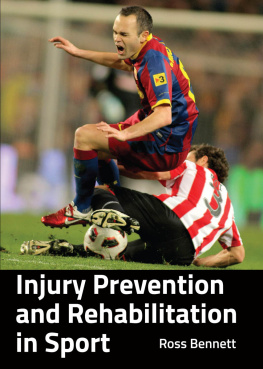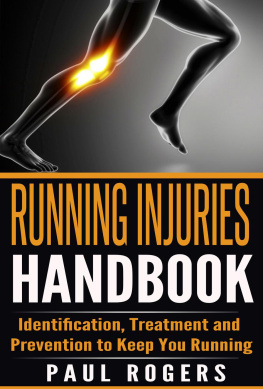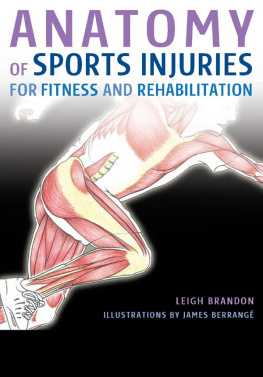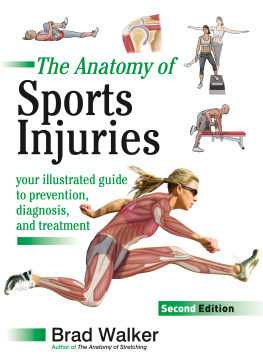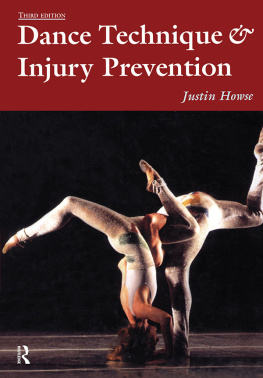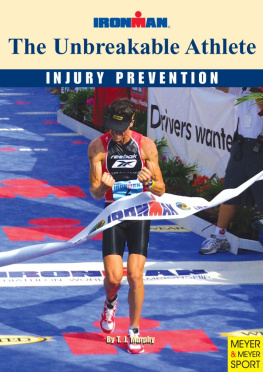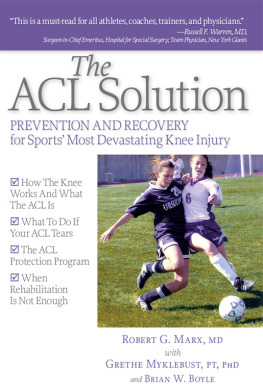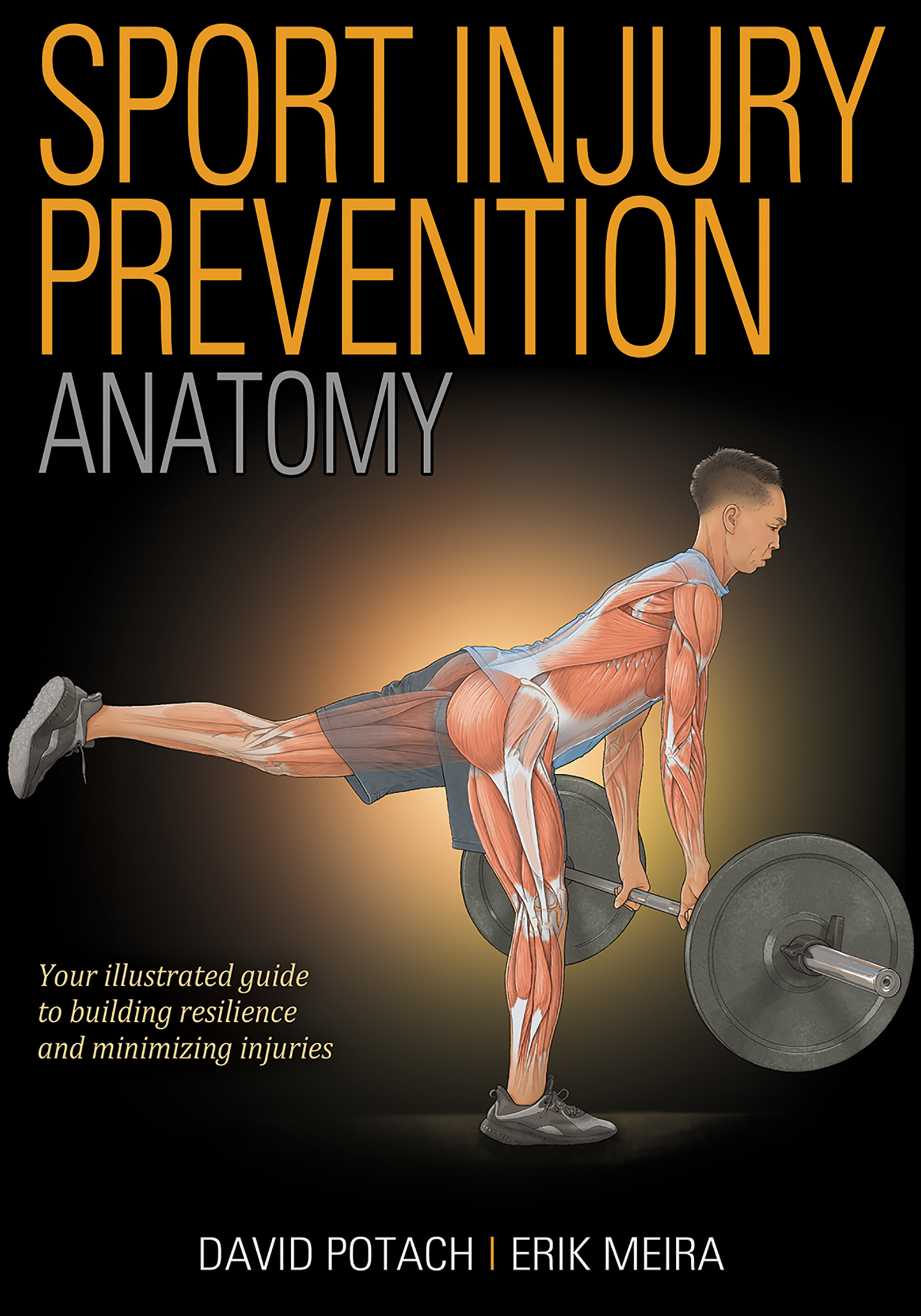Contents
List of Figures
List of Tables
Guide
Pagebreaks of the print version
Sport Injury Prevention
ANATOMY
David Potach
Erik Meira

Library of Congress Cataloging-in-Publication Data
Names: Potach, David, 1970- author. | Meira, Erik, 1976- author.
Title: Sport injury prevention anatomy / David Potach, Erik Meira.
Description: Champaign, IL : Human Kinetics, [2023] | Includes bibliographical references.
Identifiers: LCCN 2022002890 (print) | LCCN 2022002891 (ebook) | ISBN 9781718208285 (print) | ISBN 9781718208292 (epub) | ISBN 9781718208308 (pdf)
Subjects: LCSH: Sports injuries--Prevention. | Sports--Physiological aspects. | BISAC: HEALTH & FITNESS / Exercise / Stretching | MEDICAL / Sports Medicine
Classification: LCC RC1235 .P635 2023 (print) | LCC RC1235 (ebook) | DDC 617.1/027--dc23/eng/20220318
LC record available at https://lccn.loc.gov/2022002890
LC ebook record available at https://lccn.loc.gov/2022002891
ISBN: 978-1-7182-0828-5 (print)
Copyright 2023 by David Potach and Erik Meira
Human Kinetics supports copyright. Copyright fuels scientific and artistic endeavor, encourages authors to create new works, and promotes free speech. Thank you for buying an authorized edition of this work and for complying with copyright laws by not reproducing, scanning, or distributing any part of it in any form without written permission from the publisher. You are supporting authors and allowing Human Kinetics to continue to publish works that increase the knowledge, enhance the performance, and improve the lives of people all over the world.
To report suspected copyright infringement of content published by Human Kinetics, contact us at permissions@hkusa.com . To request permission to legally reuse content published by Human Kinetics, please refer to the information at https://US.HumanKinetics.com/pages/permissions-information .
This publication is written and published to provide accurate and authoritative information relevant to the subject matter presented. It is published and sold with the understanding that the author and publisher are not engaged in rendering legal, medical, or other professional services by reason of their authorship or publication of this work. If medical or other expert assistance is required, the services of a competent professional person should be sought.
The web addresses cited in this text were current as of January 2022, unless otherwise noted.
Senior Acquisitions Editor: Michelle Earle; Developmental Editor: Amy Stahl; Copyeditor: Heather Gauen Hutches; Permissions Manager: Dalene Reeder; Senior Graphic Designer: Sean Roosevelt; Cover Designer: Keri Evans; Cover Design Specialist: Susan Rothermel Allen; Illustrator (cover): Human Kinetics/Heidi Richter; Photographs (for cover and interior illustration references): Human Kinetics/Jason Allen; Photo Asset Manager: Laura Fitch; Photo Production Specialist: Amy M. Rose; Senior Art Manager: Kelly Hendren; Illustrations: Human Kinetics/Heidi Richter, Jen Gibas, and Jenn Tse; Printer: Versa Press
Human Kinetics books are available at special discounts for bulk purchase. Special editions or book excerpts can also be created to specification. For details, contact the Special Sales Manager at Human Kinetics.
Printed in the United States of America 10 9 8 7 6 5 4 3 2 1
The paper in this book is certified under a sustainable forestry program.
Human Kinetics
1607 N. Market Street
Champaign, IL 61820
USA
United States and International
Website: US.HumanKinetics.com
Email: info@hkusa.com
Phone: 1-800-747-4457
Canada
Website: Canada.HumanKinetics.com
Email: info@hkcanada.com
E8398

CONTENTS
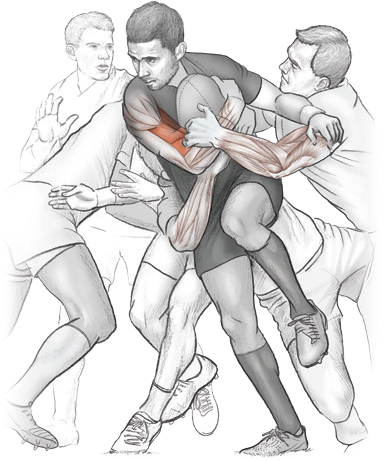
INTRODUCTION
Being active is an important part of a lifelong healthy lifestyle. Physical activity improves heart and muscle health, boosts stamina and mental acuity, and helps control blood sugar and weight. Fortunately, many have gotten the message about the benefits of physical activity: Sport and exercise participation rates have generally increased over the past 20 years. Looking more deeply at these numbers, however, reveals that formal team sport participation rates have steadily decreased and that physical activity participation also decreases with age. Although reasons for these changes are multifactorial, one of the common causes is declining health and injury. Many athletes retire from sport participation at a young age because of injury and inability to return to their previous level of performance. Because of the many advantages of physical activity, it is beneficial to find ways to reduce the risk of injury and keep people actively involved in sport and exercise beyond their youth.
When applied to sport, exercise, and physical activity, the goal of injury prevention is to promote healthy lifestyles by reducing the risk of injury and improving the health and quality of life of both individual athletes and teams. This is best accomplished through the performance of specific exercises while following proper exercise or sport dosage and timing guidelines.
But is injury prevention possible? Before answering that question, it is important to appropriately define what is meant by injury prevention ; this is more complex than it would first appear.
INJURY
An injury is defined as damage to a specific structure that often impairs intended function. Injuries are typically caused by the bodys interaction with an external objectfor example, a fall causes the body to contact the ground (external object) in such a way that injury may occurbut they can also occur as a result of acceleration, deceleration, changes of direction, playing too many games in too short of a period of time, or when the body is not properly prepared for games, activity, or exercise.
INJURY PREVENTION
The common use of the term prevention is to stop or keep something from happening, but it also means to slow, hinder, or forestall an event before it happens. Therefore, our definition of injury prevention as discussed in the following chaptersis to reduce the likelihood of an injury occurring before it happens. We do not believe it is possible to stop all injuries from happening. Instead, we believe that proactively addressing specific risk factors before injuries occurlike performing certain exercises and using proper exercise and activity guidelinescan indeed prevent some injuries and reduce the risk and severity of others. We will continue using the term prevention but with the stated definition in mind.
DECREASED INJURY RATE
Whether targeting specific anatomical structureslike the ACL, ankle, or hamstringor specific sports athleteslike runners, wrestlers, or soccer playersthe evidence is overwhelming that injury prevention programs do indeed reduce the risk of injury. In fact, some studies have shown that participation in these programs can decrease the risk of injury by up to 75 percent! Injury prevention programs that have been researched include those for specific injuries such as


